Key to Kiwifruit productivity in 2018
As first seen in The Orchardist, May 2017
Ruth Underwood, Horticultural Consultant, Fruition Horticulture BOP
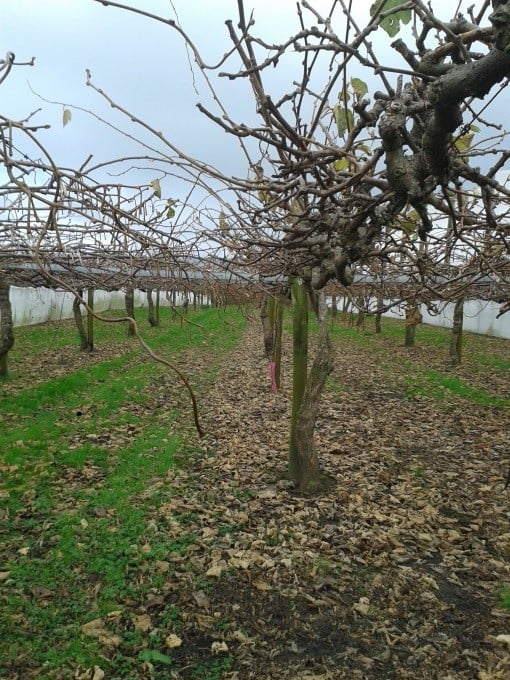
Kiwifruit winter pruning is the start of the seasonal growing cycle and sets your crop potential for the next harvest.
A quick re-cap of the basics:
A high proportion of kiwifruit flowers survive through the season to harvest. This makes it relatively easy to quantify the amount of fruiting wood you need to bear your target crop.
Fruit is carried on ‘current’ seasons wood, that grows from wood that grew during the past season. In winter, you are laying down the wood that will produce new shoots next spring that carry the fruit.
Wood that grew for the full previous season tends to produce the most flowers. Only the first flush of shoots each season carries flowers, so seeing stalks from recently picked fruit is a good indicator of mature wood. The less suitable late-grown wood tends to be stalk-less and greener in colour.
Keeping male vines narrow and spurry increases fruiting canopy area.
Good sun exposure is another indicator of quality fruiting wood, which will depend on how open the canopy was through the last season.
Lower vigour wood has the buds closer together. Moderate vigour wood is usually most suitable at winter pruning as it has a reasonable length, helping you to fill the canopy, and plenty of prominent buds, close together, encouraging good flower production.
Setting your pruning targets
Use information from harvest and previous seasons to guide your pruning.
Set a realistic yield target and allow for losses through the season including spring flower abortion and thinning off rejects. Figures from previous seasons monitoring are a useful guide. You can work back from your targeted yield to numbers of flowers required in spring. To convert those to quantity of wood at winter pruning, a key ratio is flowers per winter bud. In a poor season this can be 0.8-1 on Hayward; whereas in a good season there may be around 2 flowers per winter bud. Knowing typical figures for your variety and orchard is a great help when setting up your winter pruning. Target fruit size is an important factor as large fruit size increases trays produced and vice versa. Because we are pruning before we know key factors like how cold the winter will be and how warm or ‘decisive’ the spring will be we need to build in a margin for variability.
It’s a compromise! Assuming everything will go well for the rest of the season means you’re at risk of producing below potential from normal seasonal variations. If you are too conservative, you can tip beyond having good control of production to potentially having a difficult vine canopy and high production costs.
As the winter progresses, you can refine targets a bit as you gauge what the winter chilling has been like. Remember though that winter chilling is not the whole picture for flower production.
If you have covered blocks in your orchard, you will be building up information about the flower to winter bud results and further losses during the season. Being significantly warmer through the winter will reduce winter chill but a warm spring is hugely beneficial and should result in better retention of the flowers produced. You need to be conservative while you build up your information about the impact of covers but can fine-tune pruning as you develop records from a range of different winter and spring conditions.
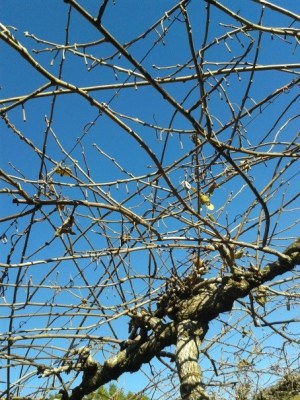
Work your production targets back to winter buds required per square metre of female orchard canopy, by taking off the proportion of the orchard in male-vine canopy. When it comes to doing the actual pruning, you’ll need a simple working version such as ‘canes every 30cm on the third wire’ or ’15 canes per side per bay’ to work with. Working to buds per square metre is more appropriate when using lots of older wood where the winter buds are borne on spurs and short canes.
This Hayward vine before pruning has good fruiting wood options with lots of “fruit stalk cane” with prominent winter buds.
Fruit payment incentives reward good performance and reduced variability. Having the canopy more even across the orchard starts with even winter pruning.
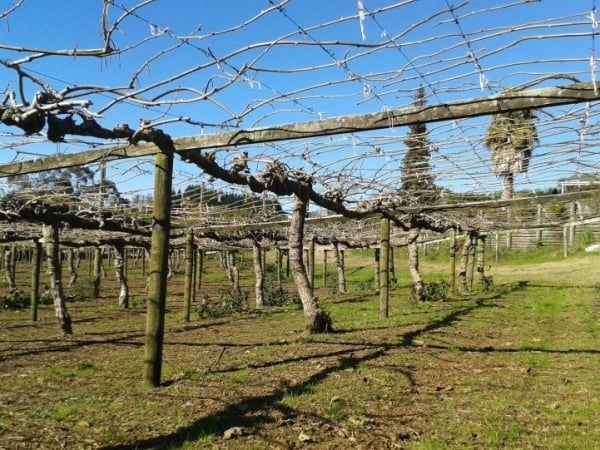
When translating your targets to winter buds per square metre or canes per bay, the target needs to be adjusted if bays differ. Male vine layout can create a key difference between bays. Some male vine arrangements create 2 types of bays – those with some of the area occupied by male vines and those that are all female canopy. Bays with only female canopy need a little more fruiting wood to offset the reduced fruiting canopy in bays part-occupied by male vines. Otherwise, you may be creating un-evenness within the orchard or limiting your overall crop if the targets were worked out for the female bays then just less wood tied down in the male bays.
Spurs and short canes provide fruiting wood near the vine leader.
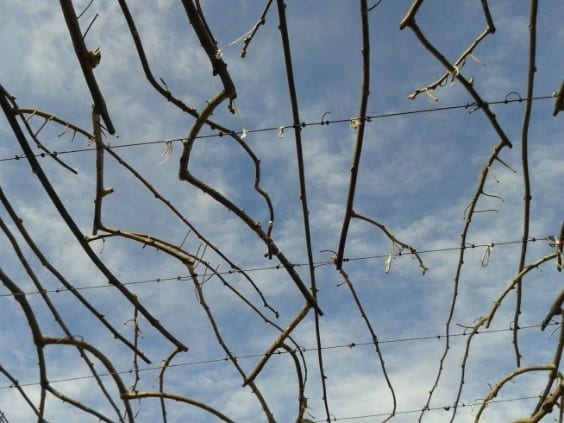
Spreading fruiting wood well across each bay helps production and quality. Every bay with below-target quantities of wood reduces your potential crop and ability to adjust to seasonal conditions. Unevenness between bays reduces the efficiency of your sunlight capture by crowding some bays and under filling others.
This vine is tied down evenly with a mix of wood age
If you have vine restructuring to do, don’t do it all in one season and reduce your production. Time and time again, I see vines where there have been significant cuts made that have reduced the crop below target potential. People say: “Vines have been given a good tidy up”; “it had to be done and vines will be in better order for next season”. They will be tidier but you may be rueing the lower yields driving your income over the next two years! Restructuring can be successfully spread over 2-4 years whilst maintaining potential productivity and income.
Small gains
You can fill in gaps with temporary fixes: train an occasional cane parallel to the vine leader if you are short of fruiting wood close to the leader; bring a cane across from the other side of the vine to fill a gap; keep older wood where there are some good spurs on it that will fruit the next season. You can’t take these measures too far or you have chaos, unmanageable summer growth and potential issues with dense canopy, disease and poor pollination.
Review male vine size and positioning before you start pruning so you can benefit from any changes as soon as possible. You may be able to reduce the size of existing male vines and tie female wood into their place. Keeping the male rows narrow is especially important in a strip male orchard with narrow row spacing. Broad male vines can be occupying 20-25% of the orchard area with no gain in pollination– just reduced production.
Consider whether a hanging curtain opposite male vines is worthwhile for you. These miss out on a bit on sunlight so may be lower dry matter fruit but can be a significant production boost if you can keep the males well-trimmed and don’t bash all the fruit driving through the block.
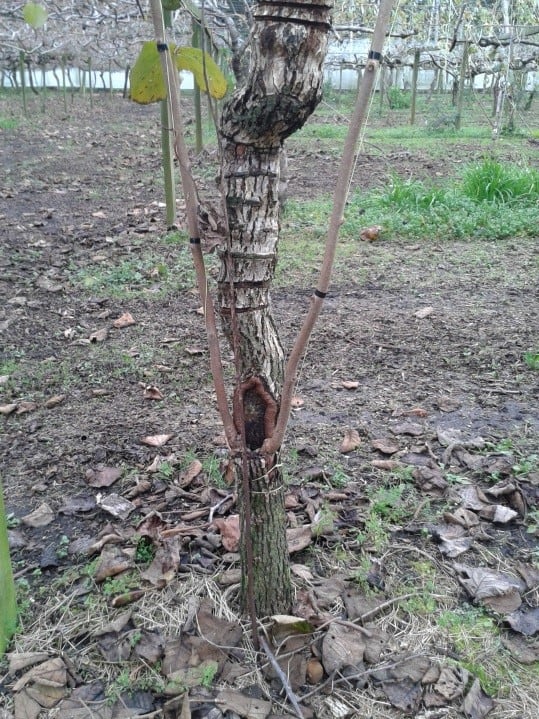
Notch graft higher than this if you have a nice straight piece of trunk.
Similarly, skirts at the edges of blocks provide useful production if there is room for them and the fruit is well pollinated. Having male vines in the outside row helps or timing supplementary pollination for these rows if they are a little later to flower.
Sick vines need to be tracked and dealt with. Training in a longer leader from a neighbouring healthy vine is a useful way to fill in a gap. If replacing the vine, add a generous amount of compost to the planting hole, especially if the block isn’t irrigated. If you have Armillaria, sluicing is a successful treatment although you may want to do this later in the autumn or winter when the soil has cleared the excessive April rainfall.
How to boost up weak vines
If you’ve carried much of the crop on weak spurs on two-year old wood, you may be having trouble filling up your orchard canopy. First check if there is some underlying issue like roots being water-logged, wind exposure or Armillaria that is holding back these vines. Fix that if you can.
In a canopy that isn’t strung, consider setting up strings just for the areas where canopy development is lagging. This exploits the vines natural growth habit of strongly growing upwards and it will be close to the leader so make good fruiting wood for you in future seasons.
Otherwise, ensure you make most cuts where you want to stimulate regrowth and not where you don’t want it. You don’t want to get into a situation where each year your best wood grows so far from the leader that you mostly remove it. You are likely best leaving winter wood with new growth some distance from the leader and cutting a neighbouring cane near to the leader to stimulate regrowth there.
Young Vines!
Time spent training young vines is seldom wasted – this can include selecting a better trunk or leader than the one trained in already. Watch for tapes or ties strangling permanent wood – the trunks or leaders – and remove them.
How do you make the transition from a young-vine canopy where you ‘keep everything and just arrange it as best you can’ to an orderly canopy where there is enough fruiting wood to renew a good proportion of it each year? Compromise! Make some of the hard cuts but leave enough wood to make your target even if it is not the wood you really want.
Disease control
All pruning creates a disease entry site so ensure coverage with preventative sprays fits around your pruning and aim to prune dry vines in fine weather as much as practical. Larger cuts should be protected, with smaller sizes treated if you have to work in less favourable weather. Clean pruning equipment regularly and mark disease cankers for hygienic removal.
Tying Down
Tying down is a big part of the success of the whole winter pruning job. Vines left with the right quantity of wood and cuts made in the right places need to be tied down with the cane as evenly spaced as possible to make best advantage of the sunlight that will be captured by the leaves.
Breakages may well occur at tying down – made worse if there is cicada-damage to canes or when tying down on frosty mornings. Tying as you go helps to assess whether you are getting the intended numbers actually tied into bays – you may need to leave 1-2 canes more per bay at pruning if there’s a significant number of breakages. Watch also that any cuts made to the ends of canes at tying down are appropriate as shortening each cane can put your bud numbers behind target and it often removes closely-spaced buds. 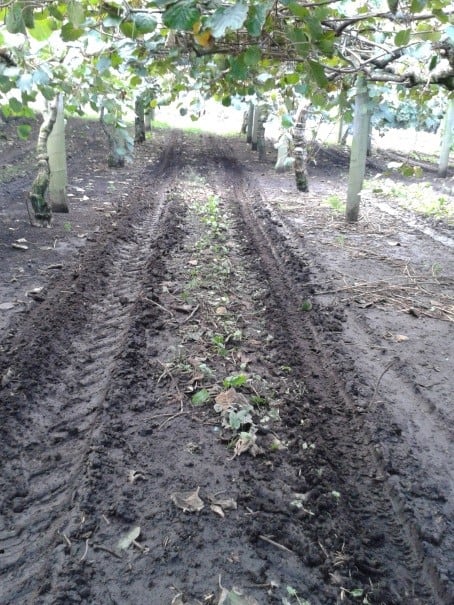
Where you just don’t have the numbers you want, still space canes further apart even if they radiate from the leader rather than being arranged at right angles to it. They will capture more sunlight, need less summer work and may help to lift wind above the canopy too.
It’s the tying down that also makes your ‘fixes’ work – those canes left to fill in the area around the leader only do that if they’re tied into the right place! Otherwise, they just clutter and don’t capture the additional light and space you intended.
Wet soil in this orchard meant harvesting equipment left deep tracks.
Grafting vines
If you are grafting to a new variety this winter you’ve probably already decided your strategy. You need to create light and space for the new graft to grow and tend it well through the season. Some growers have had good success notch-grafting so producing one more crop while the new variety gets established. However, done badly, both crops can suffer.
If you are notch grafting, I’d aim to graft quite high on the trunk so you have more mature rootstock trunk available for girdling or future variety changes. The exception to this is if you are removing Hort 16A and need the graft low enough to remove all that variety.
Also don’t neglect the parts of the orchard staying as they are – they are the areas providing the cash flow while you get back to full production!
What are the likely impacts of the wet autumn?
There will be flow-on impacts from the wet autumn in 2017. The most severe effects are on those orchard areas where the vine root systems were flooded for several days. Even where vines and support structures have come through the flooding intact, these vines will have suffered from lack of air in their root zone. Kiwifruit are especially sensitive to this.
There will also be effects on small areas in many orchards like where vines in a dip suffered root zone waterlogging. Some of the vines I’ve seen had browned leaves on their replacement canes within a couple of weeks as a result of the waterlogging. Impacts are likely to continue to show up in the spring, as poor or delayed budbreak, poor spring growth and small fruit size. Strategies you can use to help vines recover include:
- Avoid sending heavy machinery through affected areas, especially while the soil is still wet. This weight will further compact the soil while it is in a sensitive state, reducing soil aeration for longer. If you have to take gear in there, stick to existing wheel tracks and reduce weight where possible – such as by doing that area towards the end of a tank of spray when there is less weight.
- Omit ActigardTM on these vines as the defensive-response it generates in the vines may further stress them.
- Clear silt from around the vine trunks so it doesn’t create a crust that further blocks air from getting into the soil.
- Add a generous amount of organic matter around the vines in the affected area – but not touching the trunks – this provides good material for new roots to grow in which will help the vine to recover.
- If water collected from ponding or run-off, adding local drainage or clearing existing drainage pathways can help. Where possible divert run-off from areas like tracks away from the vines into tolerant areas.
- Restrict the cropload on vines in affected areas for the 2017/18 season. The vines need leaf area to help the roots to recover so don’t do this by harshly winter pruning the vines. They have reduced cropping capacity while they recover, so thin flowerbuds early in spring back to a low or moderate crop load.
Follow-up!
If you have strings, train shoots onto them early in spring and keep going back to direct growth up the strings – you might need to do this as often as weekly during rapid periods of growth.
Make flower counts in spring as soon as you can be confident the buds you will count are unlikely to abort.
If you have excessive flower numbers so a big thinning job – you can help contain costs and still improve the relative leaf area by tweaking off whole shoots that have weak growth and many flowers.
In summary, winter pruning by choosing enough suitable wood to accommodate a range of growing season conditions, tied down well, is key to good kiwifruit orchard productivity in 2018.
Very interesting comments for new growers
Very useful , thanks